MXA’S 2006 KTM 250SX DIRT BIKE TEST
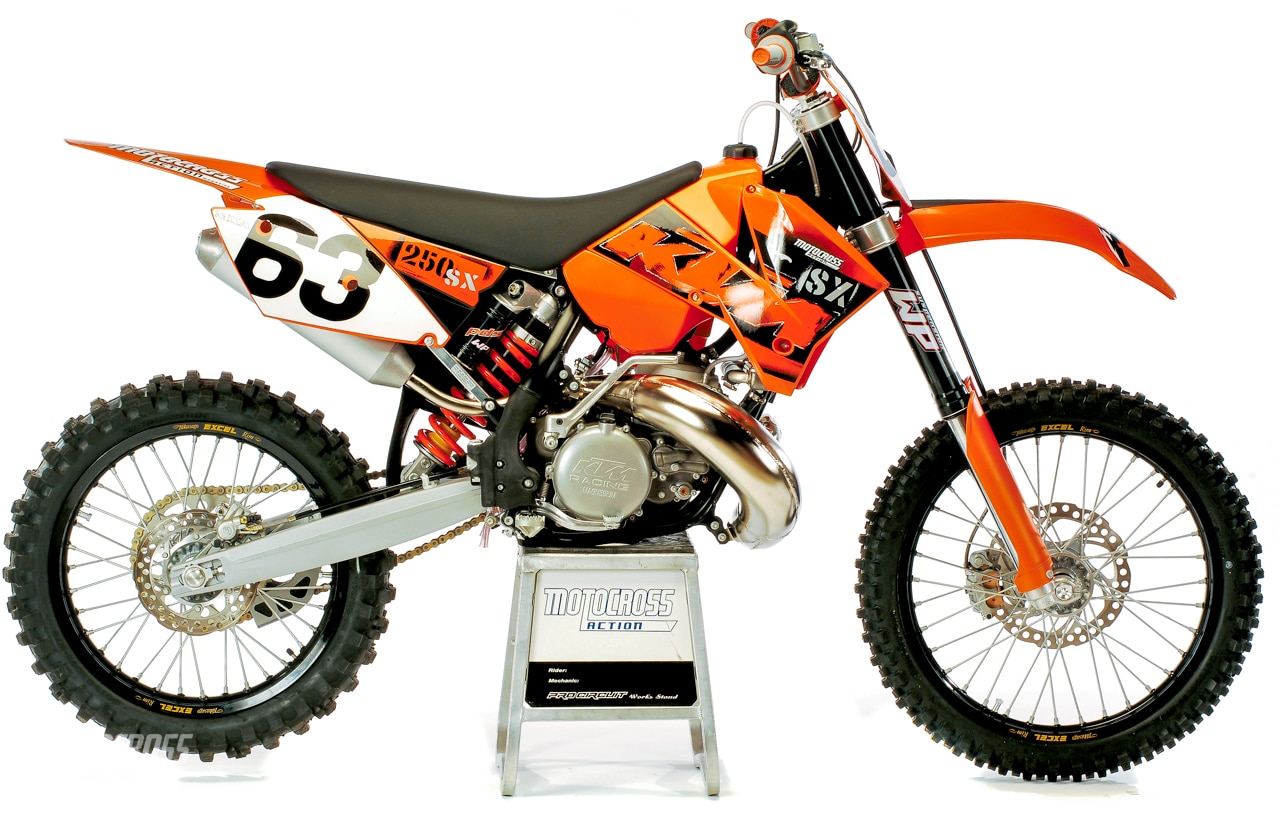 This Motocross Action achieved article of the 2006 KTM 250SX is from the 2005 November issue.
This Motocross Action achieved article of the 2006 KTM 250SX is from the 2005 November issue.
KTM is the smallest of the Big Five. It doesn’t have the massive output in scooters, golf carts, power equipment, automobile engines, oil tankers, airplanes and motocross bikes of Honda, Yamaha, Suzuki and Kawasaki. But small isn’t necessarily a bad thing!
There are advantages and disadvantages to being lean and mean.
(1) A smaller company can respond faster to changes in the market place. KTM uses this advantage to build niche machines like enduro bikes, limited run cross-country machinery, and mid-size engine displacements (200, 300 and 525) that the massive corporation can’t justify.
(2) Unfortunately, the economies of scale don’t favor small companies. Price breaks come with quantity orders, and when Honda places a rim order, they get the best price per unit because they order in six digit numbers. Economy of scale is one of the main reasons that Kawasaki and Suzuki formed their production alliance.
(3) Small companies can focus their engineering on specific goals. KTM’s offroad efforts aren’t diluted by cruisers, generators, outboard engines or watercraft (although they recently spun off a MotoGP road race program).
(4) Running changes are possible at small companies because bikes roll off the assembly line over a much longer production schedule. Thus, a problem can be fixed while bikes are still on the line. The Big Four fabricate the complete run of a specific model during a one or two week time period. The only running change possible at the Big Four is at the dealer level.
It’s not whether you are big or small, but what you do to accentuate the positive and downplay the negative. The question is–has KTM done that with the 2006 KTM 250SX?
Q: IS THE ‘06 ENGINE FASTER THAN THE ‘05?
A: No, but that isn’t a negative. The 2005 KTM 250SX engine was a marvelous powerplant. It made more horsepower than any other 2005 deuce-and-a-half. Not just a little more power, but a lot more. KTM didn’t have to outdo their 2005 engine. It was already the class leader. They just had to avoid ruining it.
Q: DID KTM IMPROVE THE POWERBAND ON THE 250SX ENGINE?
A: Yes. With three little changes KTM’s engineers made the 250SX snappier, more responsive and easier to ride. That’s like improving on the Mona Lisa.
Q: WHAT DID KTM DO TO THE 250SX ENGINE?
A: KTM’s engineers were lucky. Instead of trying to pep up a dog, they had a potent and powerful powerband to work with. This is a win-win for an engineer. It means he can give a little to get a little. Here is what KTM did to the 2006 250SX two-stroke engine.
(1) Power valve. Borrowing a page from Yamaha, KTM moved its power valve closer to the piston. Yamaha pioneered this trick about six years ago and has moved their power valve incrementally closer with each new model. Moving the power valve closer to the piston helps seal off the exhaust ports so that extra volume doesn’t hamper the charge.
KTM’s power valve flapper used to be closer to the piston as it rose higher in the exhaust port. For 2006, it is closest when it is in the down position and farthest away as it swings open. This little change adds snap off the bottom (especially when combined with a new main spring on the power valve governor).
(2) Carburetor. KTM was willing to trade some of its massive peak power to gain throttle response in the middle. They achieved this with an age-old solution. They downsized the bore in their Keihin PWK carb from 38mm to 36mm. A smaller venturi is responsive to lower pressure changes, which means it flows fuel sooner and more efficiently at low rpm throttle settings than a big venturi.
(3) Ignition. As with the performance of a video game, a motorcycle ignition benefits from more computing power. For 2006, KTM beefed up their CDI with a 16-bit processor (it used to be eight-bit). More maps means a better spark for each rpm situation.
Q: WERE THERE ANY OTHER SIGNIFICANT CHANGES TO THE 2006 KTM ENGINE?
A: Yes, three.
First, and most importantly, the ratio of second gear has been raised so that it is a little taller. By raising second, KTM closed a very irritating gap between second and third gear. We liked this change. In the past we had to add one tooth to the rear sprocket to disguise the chasm between the two gears. This year we tested lower gearing, but liked the stock 13/48 gearing best.
Secondly, KTM shaved a few grams off of the piston’s weight. A few grams wouldn’t mean much on the chassis, but pays huge dividends on a rotating part like the piston.
Thirdly, with a 66.4mm bore and 72mm stroke, a rider could turn his KTM 250SX into a 300SX by slipping on a 300 jug, piston and rings. Previous models required a new crank to go big-bore.
Q: HOW DOES THE KTM 250SX REALLY RUN?
A: KTM has built a superb 250cc two-stroke engine. The engine responds quickly down low. It has a snappy hit. Not smooth roll-on power, but a bark that makes the 250SX jump. When you are in a berm or deep loam, the snap is a thing of beauty. It gets the KTM on the pipe with alacrity. On hard-pack dirt, the little burp can come as a surprise, but it’s still charming.
The KTM revs quicker than the previous model, as you would expect with the new ignition maps, lighter piston and smaller carb. It doesn’t have a torquey low-to mid transition as much as a rapid one. It rushes through the middle in second gear and allows you to short-shift into third, where the rapid turnover slows down with load to transform into pulling power.
The MXA wrecking crew liked the changes that KTM made to the 250SX engine. It was snappier, quicker revving and more usable. No slouch, this powerband was a joy to use.
Q: WHAT ABOUT THE JETTING?
A: It was ballpark, but needed a little help. We think that the stock brass will be okay in the heat of summer, but might need some help in cooler climes. We kept the stock 158 main, leaned out the 42 pilot to a 40, and went for the optional NIEG needle over the stock NIEF (the NIEG is a half-clip leaner and comes with the bike).
Q: HOW DOES THE 2006 KTM 250SX HANDLE?
A: We never thought we’d see the day when KTM would try to fix the slack angles of their frame. For years, nee’ decades, KTM’s engineers have stonewalled any criticism of their frame geometry. And, the MXA wrecking crew had plenty of complaints. KTM’s have traditionally pushed (understeered) in corners. As a rule of thumb, a KTM chassis ignores all rider input and does what it wants to do (which is to miss the inside of the turn and carve a rather large casual arc). We can’t sugarcoat how poorly the last ten year’s worth of KTMs have handled. They have been runaway locomotives without train tracks.
Drum roll please! KTM has a new frame for 2006. How new? Let us count the ways.
(1) Head angle. The head angle is one degree steeper than last year. That is major. The new head angle is 26.5-degrees. What does that mean to you? A steeper head angle turns quicker, feels lighter at the handlebar and is less stable at speed (think trials bike). A chassis with a slacker head angle steers less when you turn the handlebar and wants to remain in a straight line (think chopper). The steeper head angle is a major step for KTM (and a rare one).
(2) Steerer tube: The steerer tube has been moved down on the chassis (along with being rotated to a steeper angle). Riders will notice the lower steerer tube as a higher front end. Why? Because when you move the steerer tube down without shortening the fork legs, you raise the front of the chassis. Stung by disparaging comments about their stinkbug stance, KTM combined the taller chassis with 6mm taller handlebars to try to swing the balance rearward–but actually just moved it upwards.
Q: IS THE 2006 CHASSIS BETTER THAN THE 2005 VERSION?
A: Yes and no. As you would expect, the 250SX is sharper than it was. The steep head angle plays its best card at turn-in. When you make your first move, the 250SX responds. It tucks under with authority and initiates the turn with no understeer. This is where previous models of KTMs would give up the ghost and start to push. The 2006 KTM 250SX’s first action gets a reaction out of the KTM chassis.
Is it a great handling bike? No. Turn-in is just one of three segments of a turn. The front end is still vague in the second phase of cornering–center-out. The front wheel wants to caster in the center of the turn, but comes back on line at the exit.
To sum it up, the 2006 KTM 250SX bites at turn-in, swivels at center-out and straightens out on the exit. Most MXA test riders were thrilled that the KTM got two of the three segments of a turn correct; that is two more than in the past. In a straight line, the KTM is stable and feels light.
Q: HOW DO THE 2006 KTM 250SX FORKS WORK?
A: WP has produced a fairly decent set of forks. For ’06, they stiffened the mid-valve to hold the fork higher and lightened the high-speed base valve to keep the forks from packing at the end of the stroke. These are both worthy goals, but faster riders will want the forks to be stiffer in the midstroke, while slower riders will want them to be softer at the end of the travel. That’s a conundrum.
As for settings, we ran the fork caps 5mm up in the triple clamps (remember, these forks raise the front of the frame higher and thus can be slid up into the clamps much more than last year). Our best settings were with the compression on 16 clicks out and the rebound at 18 clicks.
Q: WHAT ABOUT KTM’S WP/OHLINS PDS SHOCK?
A: The Ohlins-licensed technology in the WP shock has two pistons: one piston is speed-sensitive (responsive to shock shaft movement) and the other is position-sensitive (activated when the shock compresses a predetermined amount). For 2006, WP, which is owned by KTM, increased the independence of both pistons by increasing the slot between the two valves. This allows the bottom piston to be firmer to fight bottoming while the top piston can be more supple.
How does it work? Mediocre. It handles a wide range of bumps, but hates two situations with a passion. (1) The shock “G’s out” in situations that combine low speed and high loads. The shock blows through its travel. This upsets the chassis and the rider. (2) Under hard acceleration, the shock tends to kick in consecutive bumps. It packs a little bit with each bump and feeds that back as fast rebound. Slowing the rebound damping aggravates the packing and speeding up the rebound makes it kick higher.
The MXA test crew tried to alleviate these two problems by setting the high-speed compression at 2-1/2 turns out, the low-speed compression at 14 clicks and the rebound on 25. We tested sag settings as low as 110mm and as high as 100mm. We opted for 105 to keep the chassis more balanced. Too much race sag causes the front end to push at turn-in.
Q: WHAT DID WE HATE?
A: The hate list:
(1) Number plates: Don’t they run numbers on their bikes in Austria? If they do, where do they put them?
(2) Triple clamps: We want the fork offset set on 18mm. KTM sends it over on 20mm. You can switch it yourself, but you need a modicum of skill to do it.
(3) Gas tank: The 250SXF has a cool gas tank with an aircraft-style fuel cap (quarter-turn and big), but the 250SX gets the old tank with the teeny-weenie gas filler cap.
(4) Rims: Yes, Virginia, we know that black rims are the hip thing, but we don’t like them. They scratch under the pressure of tire irons and make the wheels look heavy.
WHAT DID WE LIKE?
A: The like list:
(1) Handlebars: Renthal FatBars. Nice.
(2) Brakes: Last year the rear brake was awesome, but touchy. It’s still awesome, but not so prone to locking up.
(3) Clutch: The new Brembo hydraulic clutch feels more like a normal clutch than last year’s Magura. Best of all, the Brembo clutch uses DOT 5.1 brake fluid instead of the Magura’s mineral oil.
(4) Sneakers: We don’t like Bridgestone 401/402s or 601/602s, but we think that KTM is on to something with the old-school M59/M70 combo. They work best on soft terrain.
(5) Pipe: Pro Circuit’s Jeremy McGrath Replica pipe is the best aftermarket product that you can put on the 250SX.
(6) Swingarm: Take a close look at the 2006 KTM swingarm. It is one-piece. No welding. No bonding. No seams. The swingarm is cast with internal gusseting that eliminates any unequal flex. It is something that KTM tested when they owned Husaberg. Very trick.
Q: WHAT DO WE REALLY THINK?
A: The little guy has to try harder. We commend KTM for the effort they put into the 2006 KTM 250SX. The little guy is trying to build a better 250 two-stroke while half of the Big Four have thrown in the towel. Kudos.


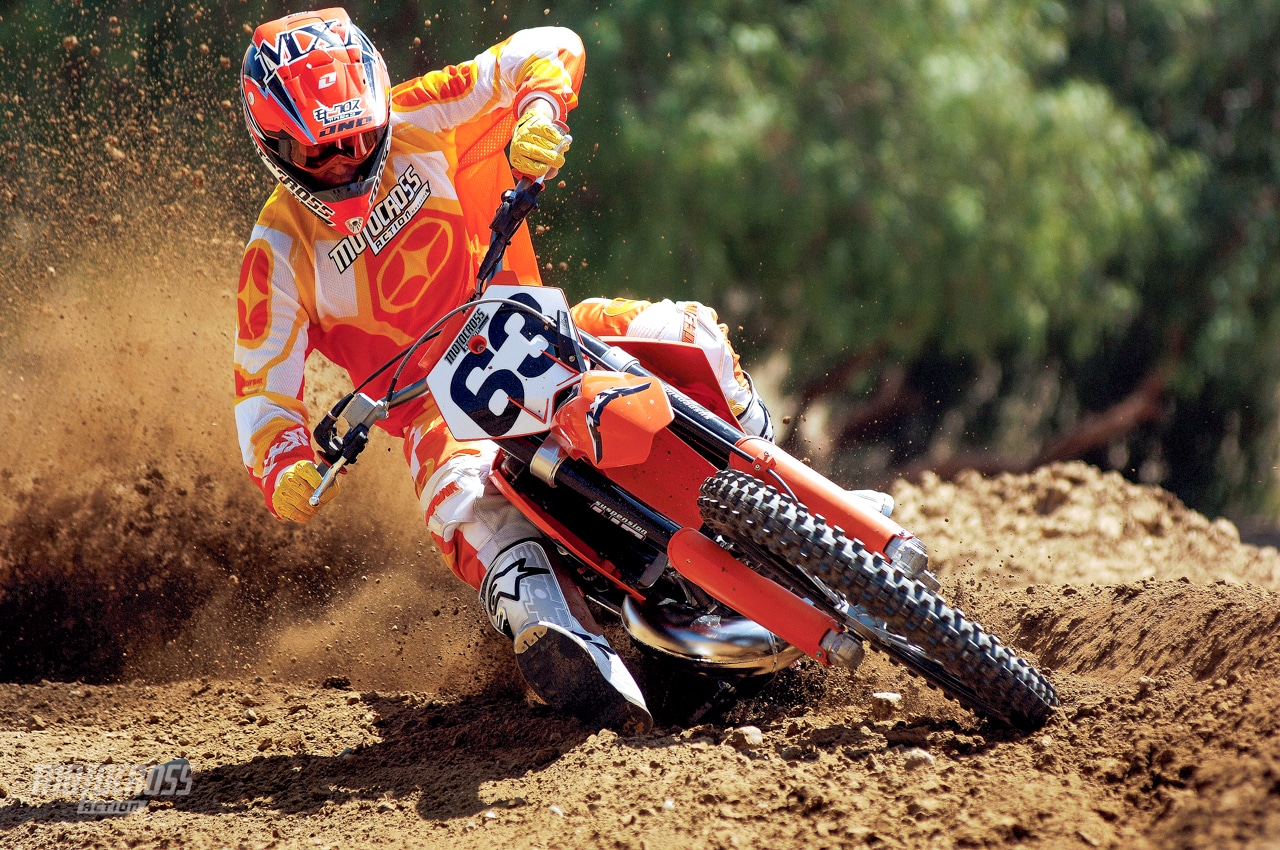
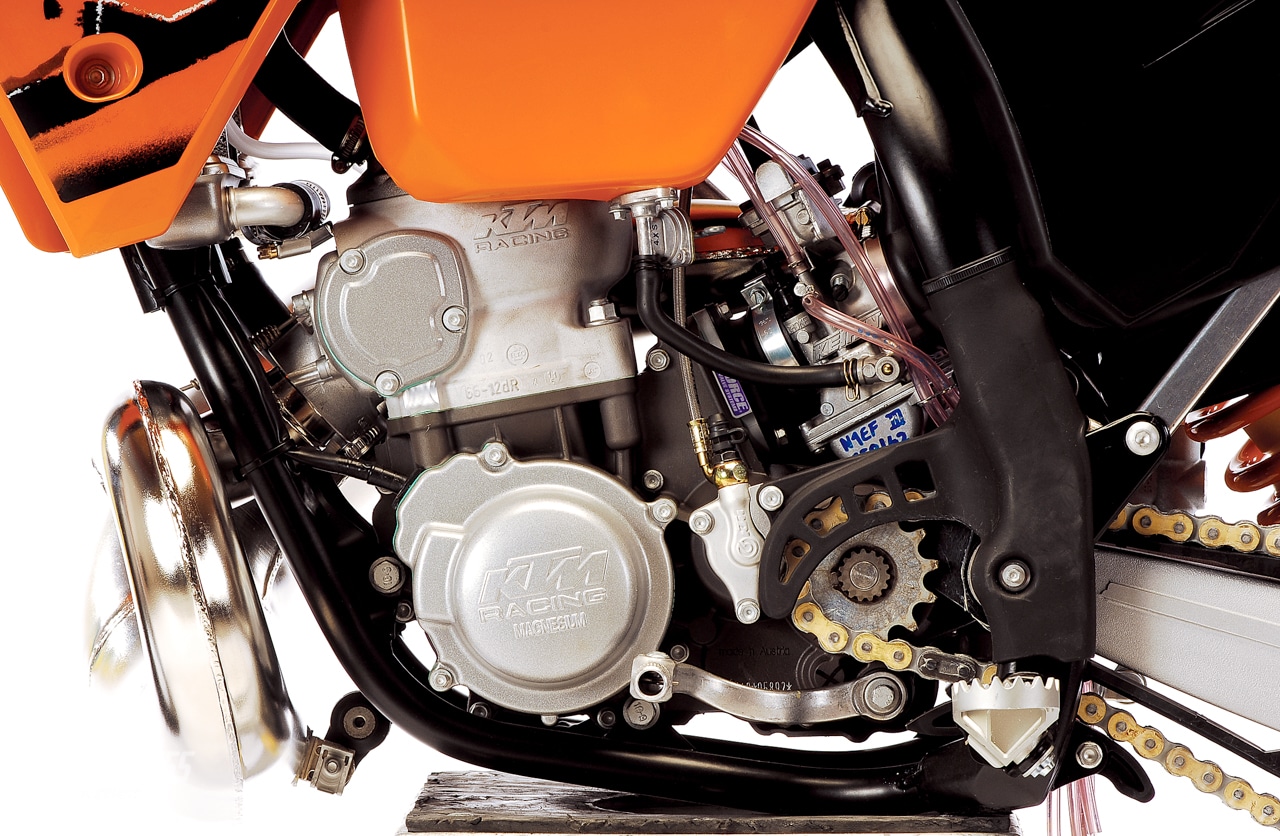
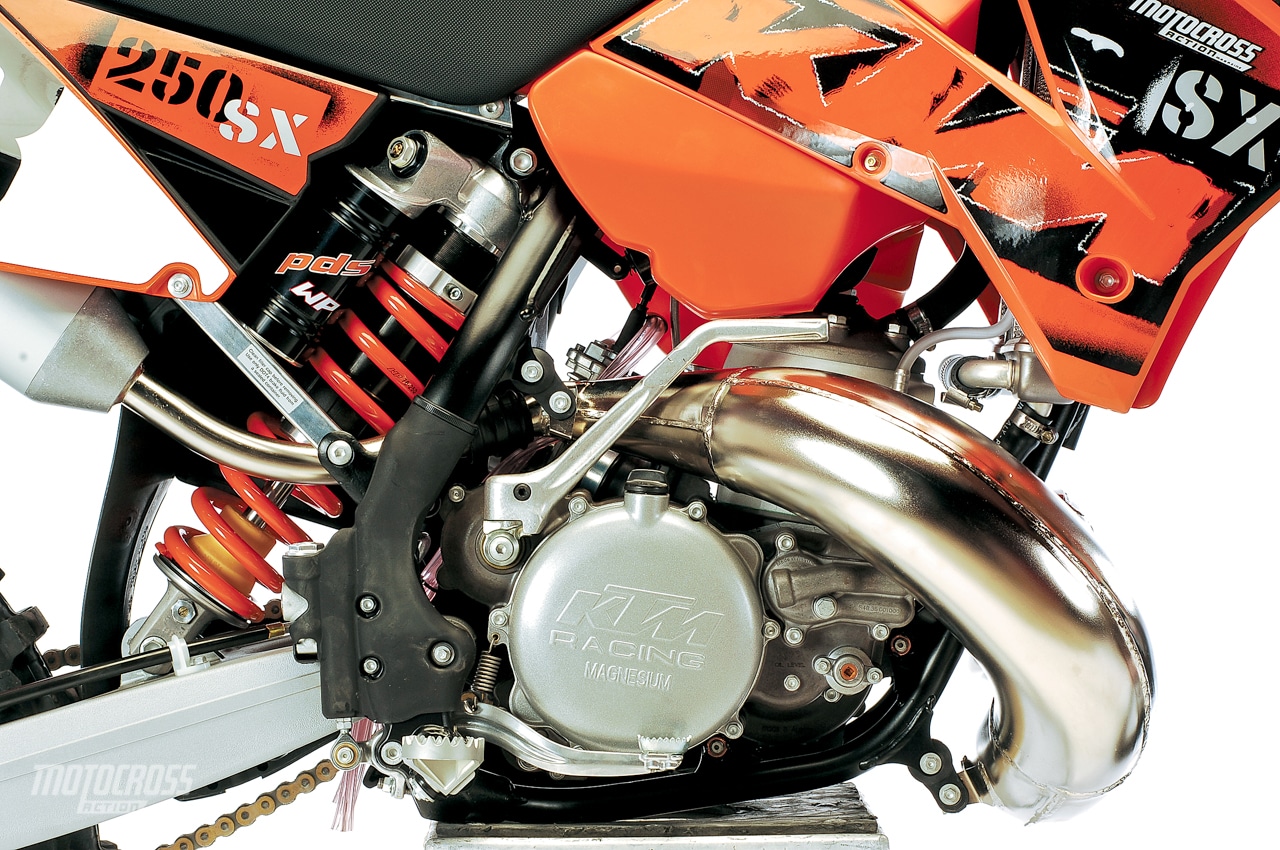

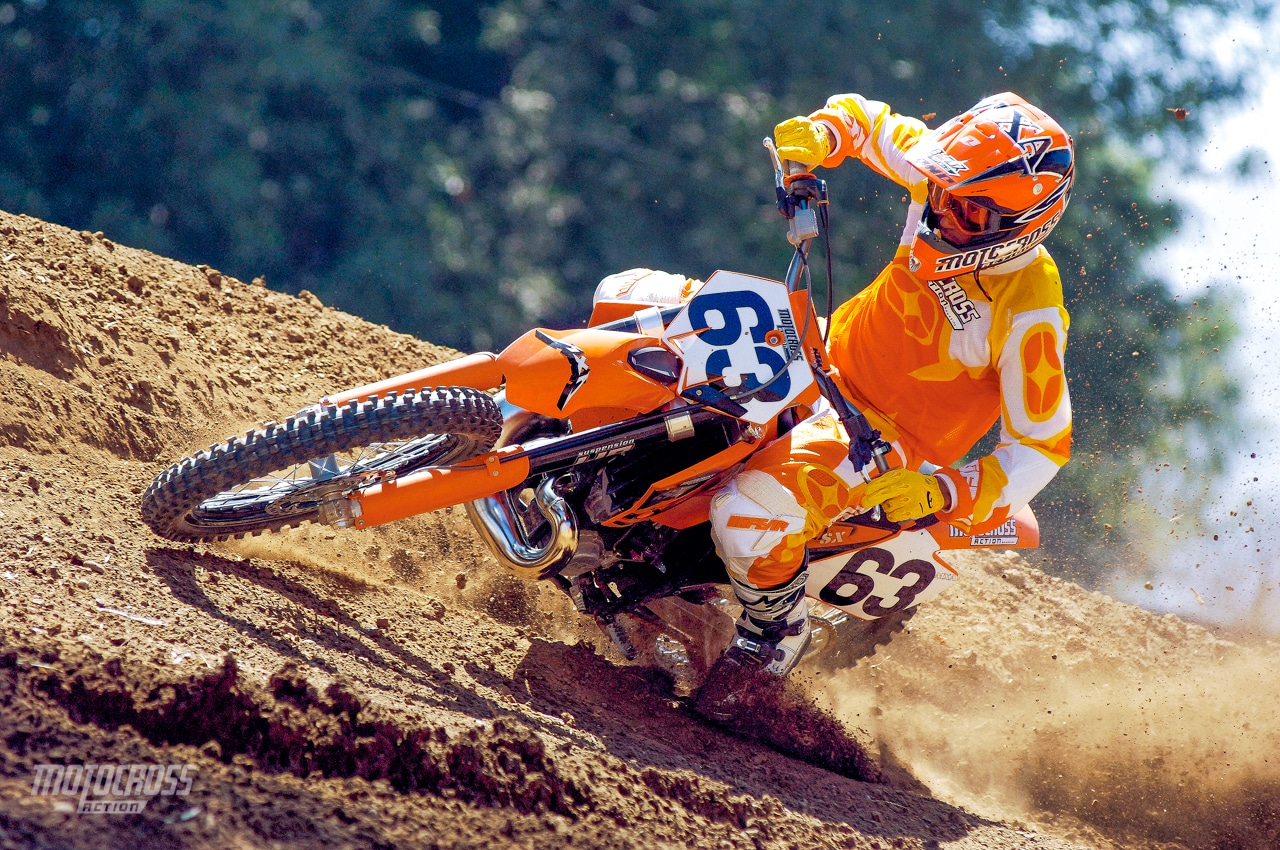
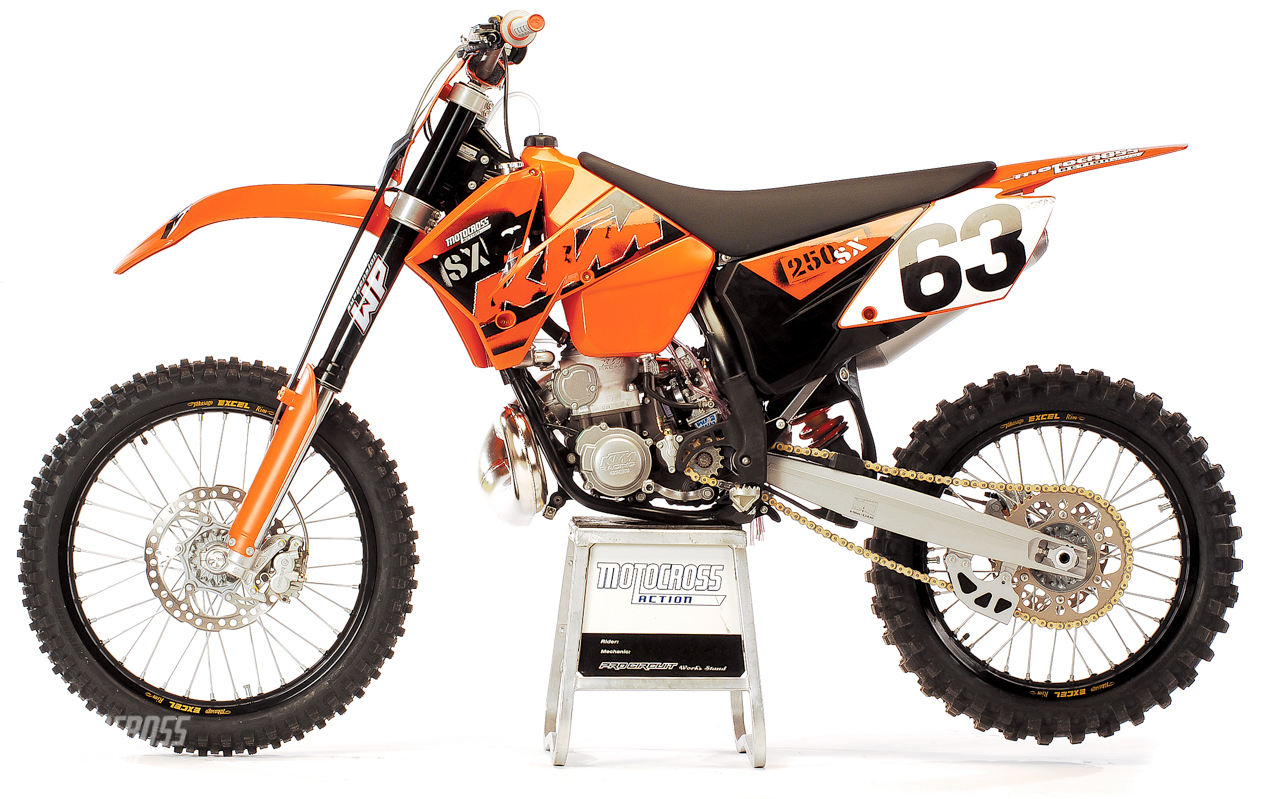
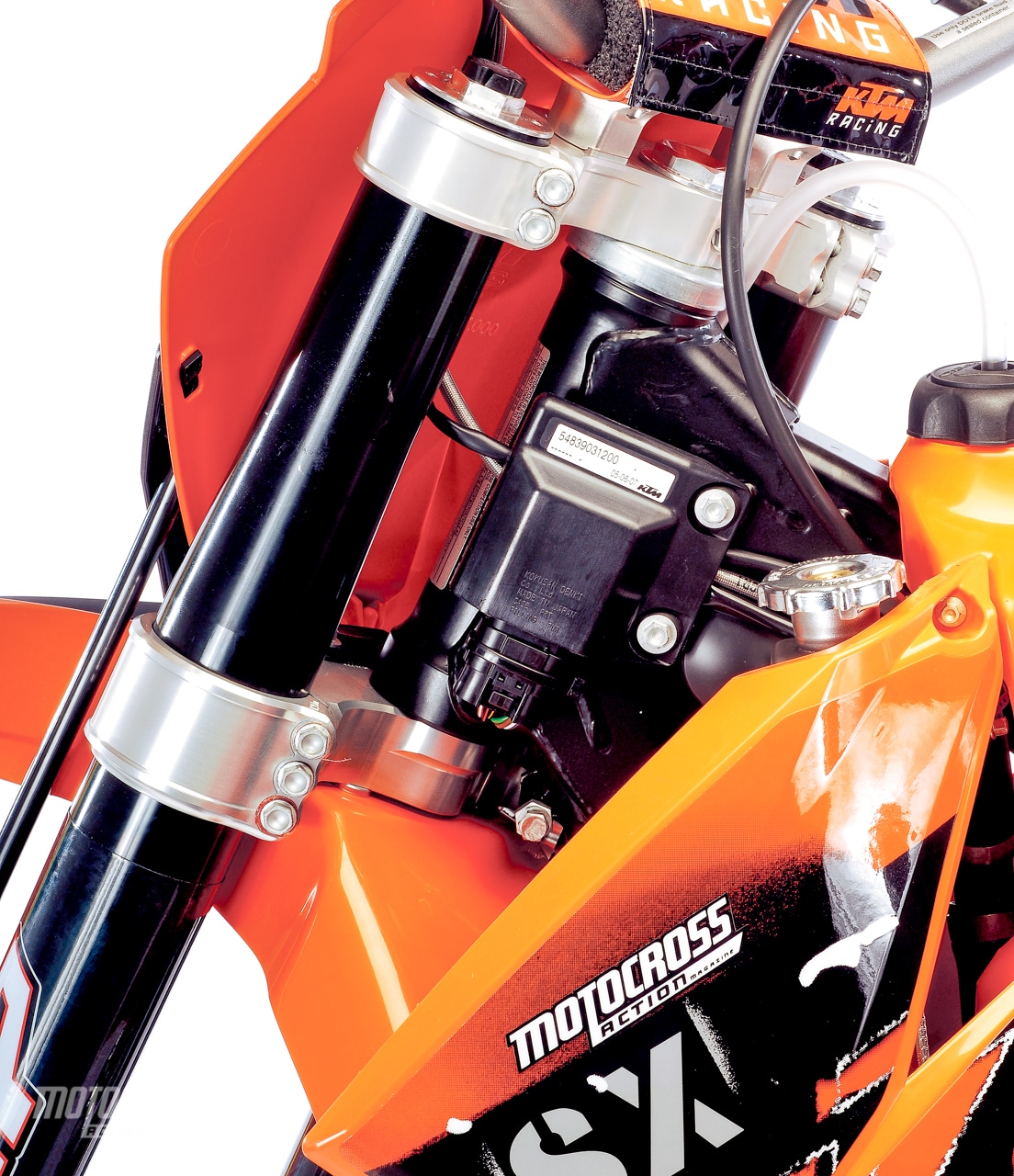
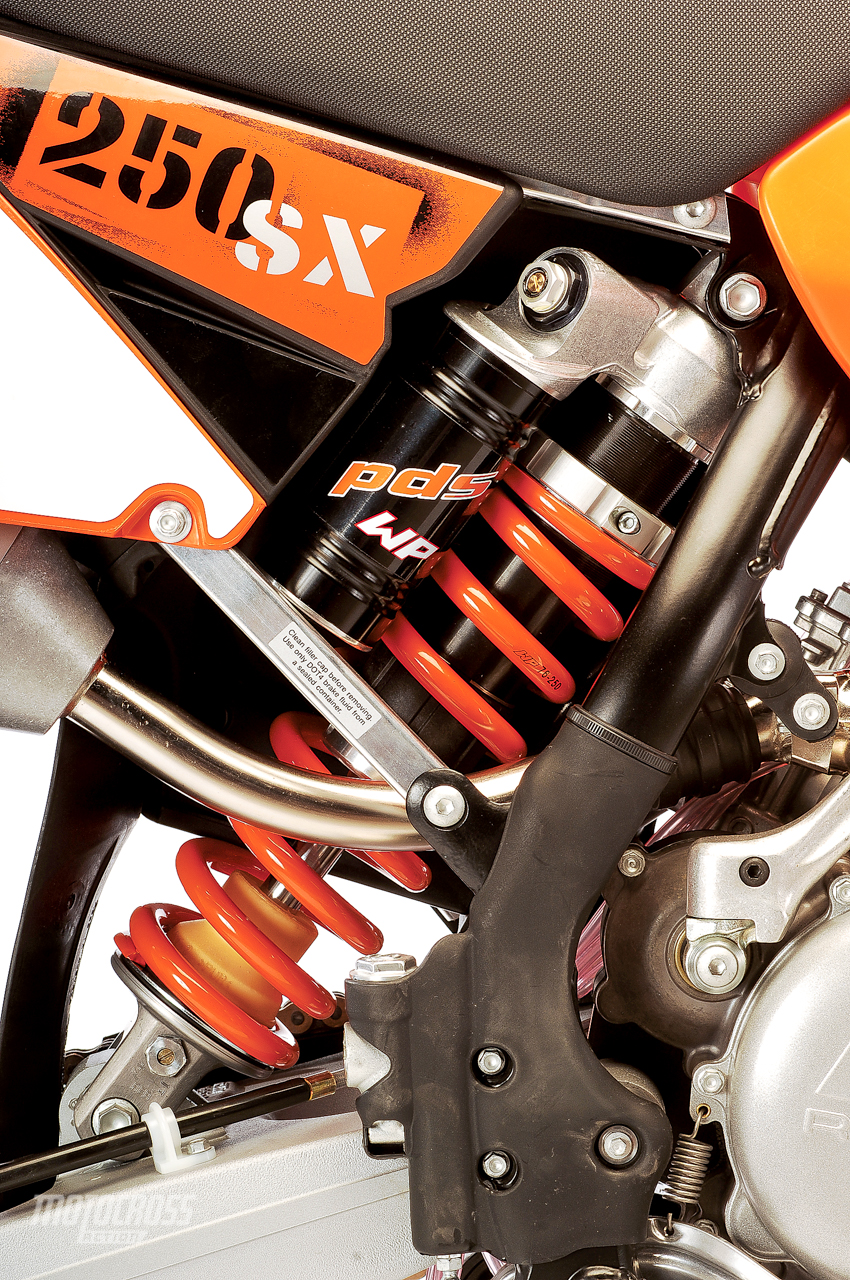
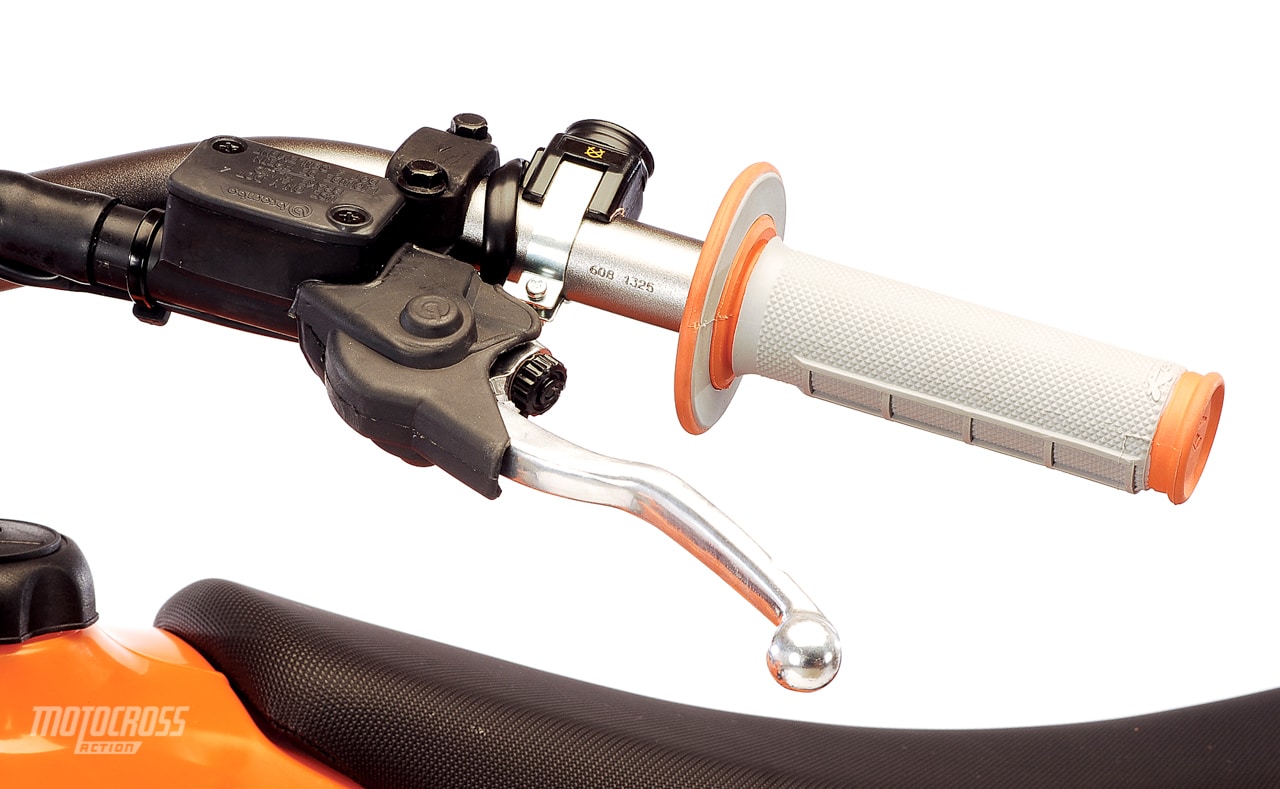
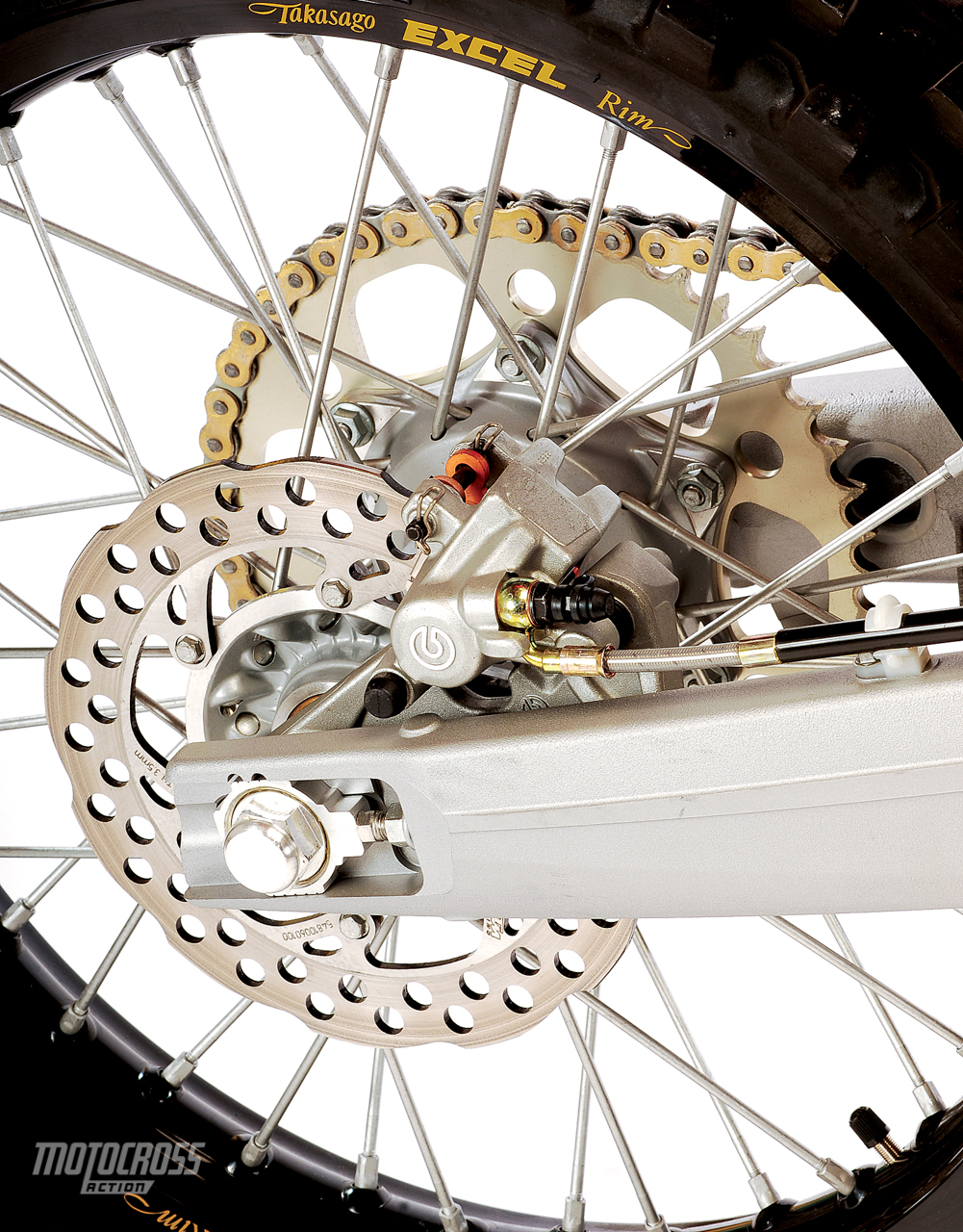



Comments are closed.